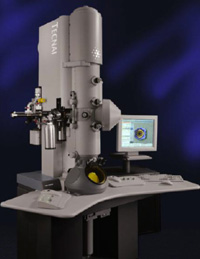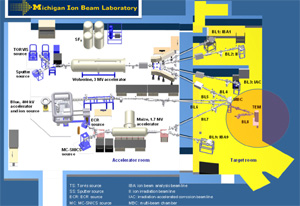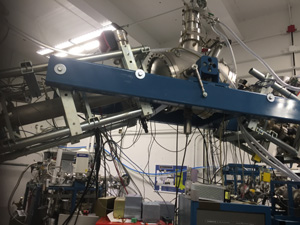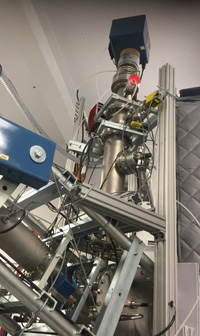Applications
- The microscope is interfaced with a particle accelerator and a low energy ion source.
- Two separate ion species can be mixed and delivered to the TEM stage for in-situ irradiation experiments.
Contact
Location
The TEM is located in the Michigan Ion Beam Laboratory (MIBL) in the North Campus. See MIBL’s webpage for full detail about the particle accelerator and experimental capabilities.
Acknowledgments
Publications, presentations, and posters resulting from work on this instrument should state: “The authors acknowledge the University of Michigan College of Engineering for financial support, as well as the Michigan Center for Materials Characterization and Michigan Ion Beam Lab for instrument use and staff assistance.”
Specifications
- Accelerating Voltage 300 kV
- Filament: Zirconated Tungsten thermal emission tip
- Gun vacuum: < 5.0 x 10-7 Pa
- Column vacuum < 2.0 x 10-5 Pa
- Resolution CTEM : 0.24 nm point-to-point
- Resolution STEM : 0.24 nm point-to-point
- XEDS System: EDAX SDD X-ray detector (active area 30 mm2) for elements with Z>5
- Gatan camera 2k x 2k for 300 kV
- FEI TIA and Gatan Digital Micrograph
- High Angle Annual Dark-field detector
- EDAX TEAM software
- FEI Low-background Double-tilt Holder (+/- 70 deg.)
- DENS MEMS heating holder
- Remote operation capability
- In-situ ion irradiation
Beamlines Connected to the Microscope
The particle accelerator interfaced with the TEM is the 400 kV ion implanter , built by National Electrostatics Corporation (NEC) and equipped with a Danfyzik Model 921 ion source. This is a single ended accelerator, that can provide ions through beamline 6 (BL6) in the 20 keV – 400 keV, single charge state, and .8, 1.2 and 1.6 MeV (2+, 3+ and 4+ respectively) for multiple ionized states of certain ions. The accelerator can deliver specific ion species, such as Kr, Xe and others as required by the users. The ion source installed on a separate beamline (BL8), is an Alphatross ion source also manufactured by NEC and capable of delivering H and He ions in the energy range of 5-30 keV.
The beamline delivery system consists of sophisticated beam tuning devices capable of sending ion beams to the TEM with wide range of fluences and sizes as required by the users. A state of the art remote control system allows these beams to be delivered form the Control Room located away from the instruments.
References
- In situ transmission electron microscopy investigation of nucleation of GP zones under natural aging in Al-Zn-Mg alloy, A. Chatterjee, L. Qi, A. Misra, Scripta Materialia, 207, 114319, 2022
- Plastic deformation induced microstructure transition in nano-fibrous Al-Si eutectics, H.H. Lien, J .Wang, A. Misra, Materials & Design, 218, 110701, 2022
- Correlating dislocation structures to basal and prismatic slip bands near grain boundaries in tensile-tested Mg–4Al using a multiscale electron microscopy approach, Y.S.J. Yoo, M.T. Andani, A. Misra, Materials Science and Engineering: A, 840, 142993, 2022
- Emulation of Neutron Damage with Proton Irradiation and Its Effects on Microstructure and Microchemistry of Zircaloy-4, P. Wang, J. Bowman, M. Bachhav, B. Kammenzind, R. Smith, J. Carter, A. Motta, E. Lacroix, G. Was, Journal of Nuclear Materials, 557, 153281, 2021
- The Role of Co-injected Helium on Swelling and Cavity Evolution at High Damage Levels in Ferritic-Martensitic Steels, D. Woodley, S. Taller, Z. Jiao, K. Sun, G.S. Was, Journal of Nuclear Materials, 550, 152912, 2021
- IASCC of neutron irradiated 316 stainless steel to 125 dpa, D. Du, K. Sun, G.S. Was, Materials Characterization, 173, 110897, 2021




